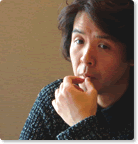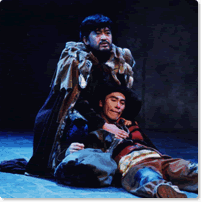One night in what appears to be a hospital ward, the “King,” rises from his bed, draws the thick drapes covering the walls, and sets off into the darkness of the night together with a “Clown.”
The King is, in fact, the Emperor who once bought from swindlers a new suit made of special material invisible to the foolish, and marched naked in a procession through the town. Now, he is suffering from a mental illness.
A countryman strays onto the stage. He is, in fact, Sancho Panza, the good squire of Don Quixote. From this point on, the scene shifts to an inn from “Don Quixote.” Here stays a jongleur, struggling with massive debts. His pessimistic daughter does not wish to believe anything other than “what the eyes can see.” In front of the girl, the King wields the “sword of truth,” presented in the jongleur’s pantomime, but she simply screams at him.
Then, NAKAGAWA Kyoko, a woman in modern clothing, walks in. She is followed by other characters that take off their period costumes to return to who they are in present time as the stunned King gazes on. They are in fact, his students, and he is, in reality, a former junior high school teacher. Because of trouble with the students, he lashed out and injured Kyoko in the face. This incident triggered his mental illness. The students say they have come to apologize for what they did, and to save the former teacher from his “nightmare.”However, it turns out to be another malicious hoax. The King is dressed in invisible clothes and left to shiver in the cold, clutching his naked body.




